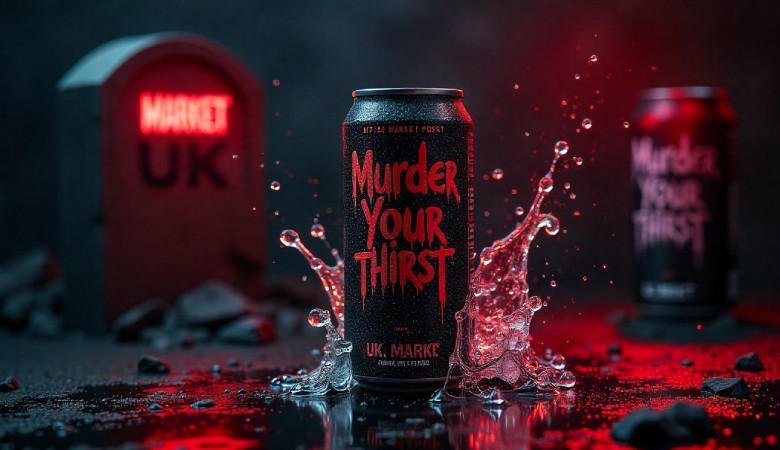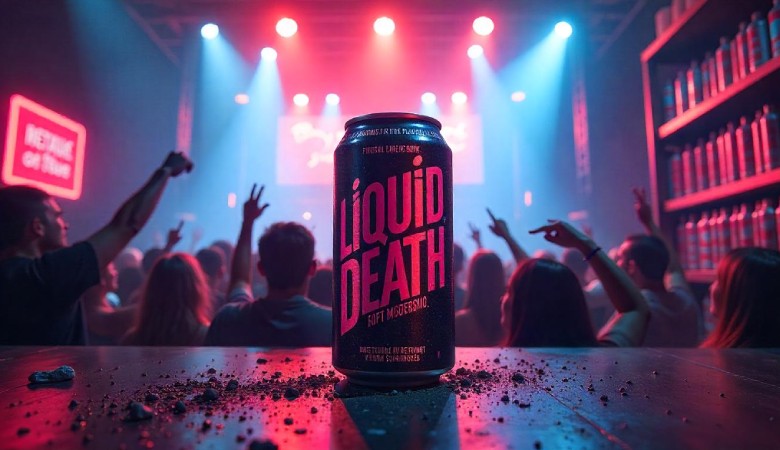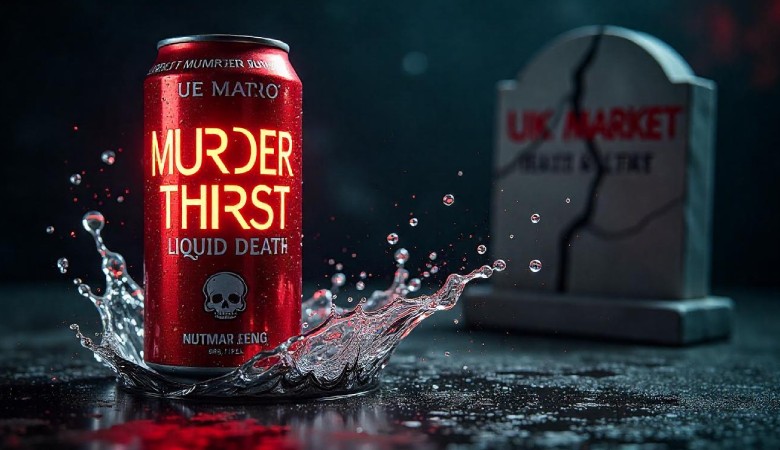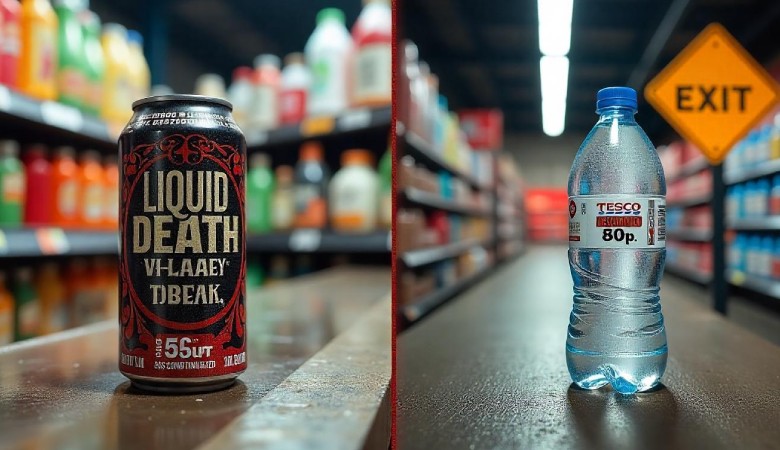Beyond the Grim: Takeaways from Liquid Death’s Journey
Liquid Death, a canned water brand renowned for its audacious marketing and commitment to sustainability, achieved remarkable success in the U.S. market but faced challenges leading to its withdrawal from the UK after an 18-month stint. While the dynamics of the water industry differ from those of kombucha, there are valuable marketing insights to be gleaned, especially for brands aiming to amplify their social media presence, penetrate retail markets, or cultivate an edgy image.
Liquid Death offers a range of non-alcoholic beverages, including still and sparkling water, all packaged in tallboy aluminum cans. The brand stands out with its provocative slogans like “murder your thirst” and “death to plastic,” which challenge conventional beverage marketing norms.
U.S. Triumph
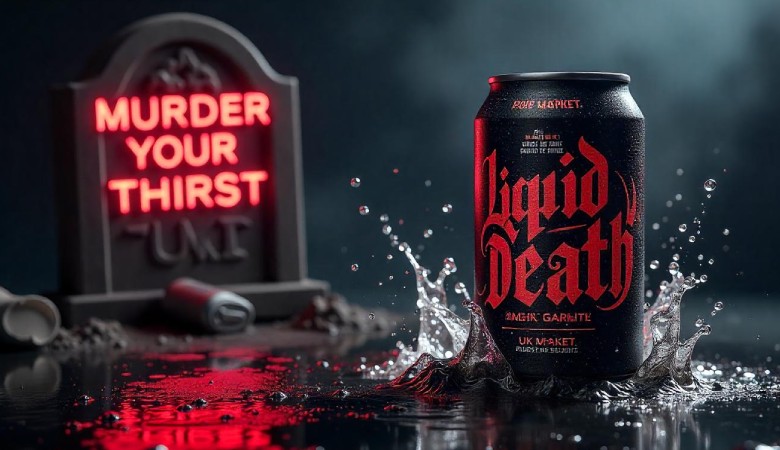
Marketing strategist Mulenga Agley, writing for Growthcurve, delves into the factors behind Liquid Death’s stateside success:
Liquid Death’s branding is built on a unique creative vision that combines humor, irreverence, and a commitment to sustainability. The brand’s founder, Mike Cessario, aimed to make water “cool” by poking fun at energy drinks and using a “dumb” name like Liquid Death.
Liquid Death is a prime example of how a company can radically shift perceptions, break into a crowded market, and build a valuation of over one billion dollars.
Traditionally, premium water brands emphasize their purity or exotic sources, focusing marketing messages on mountain springs and carefully curated pH levels. Liquid Death flipped the script by adopting rebellious branding.
Initial Marketing Approach
Agley highlights that Liquid Death carved out market share in the U.S. through a direct-to-consumer model:
Whilst many new brands focus on Instagram and Facebook content without seeing sustainable returns, Liquid Death harnessed organic engagement. They positioned their cans in bars, music festivals, and places where people naturally pull out their phones and tag what they’re drinking. That immediate social proof, combined with the brand’s “shock factor,” dramatically reduced the cost of acquiring new fans.
This tactic resonates with the evolving landscape of consumer engagement via social media. In 2024, beverage brands are increasingly utilizing platforms like Instagram and TikTok to showcase innovative drink recipes and foster vibrant communities. This strategy is particularly effective among younger audiences, with Millennials and Gen Z favoring brands that deliver authentic and engaging content.Booch News
Building upon this momentum, Liquid Death swiftly transitioned into physical retail spaces.
They secured distribution in 113,000 retail locations across the US and UK, and in doing so, they saw retail scan sales of 263 million dollars in 2023, up nearly 140% from the year before. The approach was straightforward: they used the brand’s cult-like following to convince retailers that people weren’t just intrigued online; they were ready to buy in-store.
Diversifying the Product Line
After solidifying its presence with plain canned water, Liquid Death expanded its offerings to include flavored sparkling waters and iced teas, eventually venturing into flavored electrolyte powder sachets.
This approach aligns with the growing consumer demand for functional and innovative beverages. In 2024, there’s a notable shift towards drinks that offer more than just hydration, with consumers seeking added health benefits and unique flavor experiences. The rise of functional beverages, including those infused with probiotics, adaptogens, and other wellness-oriented ingredients, presents a significant opportunity for brands to diversify their product lines.
UK Setback
James Besson, editor at The Grocer, reported on Liquid Death’s decision to exit the UK market after less than 18 months. He speculates that the premium pricing may have deterred UK consumers:
With an rsp of £5.50 per 4x500ml pack in Tesco, Liquid Death’s Mountain Still Water is almost seven times as expensive as the retailer’s own-label Ashbeck Still Water, which costs just 80p for a two-litre bottle.
Small brand growth strategist Julia Kinner, in a LinkedIn post, analyzed the lessons from Liquid Death’s UK departure.
She asserts that, unlike their U.S. strategy, the UK approach faltered due to the adoption of a scale-up model rather than a start-up one:‘Booch News
In the US they created substantial mental availability and buzz BEFORE launching in retail and built their distribution network bit by bit (=start-up approach)‘Booch News+1Time+1
Step-by-step start-up approach:
- Created a Facebook page before the product existed
- Invested a modest sum in a viral video
- Cultivated a dedicated following and attracted distributor interest
- Initial production run: 150,000 cans‘Booch News+1The Goat Agency+1
- 2019: Focused on direct-to-consumer sales via Amazon (12x500ml for $20)
- Achieved $100,000 in first-month sales with a $2,500 marketing spend
- Brick-and-mortar presence: Introduced in bars, adding value for proprietors
- Targeted distribution: Concentrated on trendy bars in Los Angeles and Philadelphia
- Scaled distribution through small distributors (comprising 80% of the market due to legal constraints)
- 2020: Expanded into Whole Foods (1-2% retail market share) at $14.99, ensuring product rotation and foot traffic
Conversely, the UK ‘scale-up’ strategy stumbled due to several missteps:
- Lower per capita bottled water consumption compared to the U.S.
- Immediate retail launch in major chains like Tesco, Iceland, and Ocado
- Insufficient consumer awareness and buzz
- Poor product turnover in storesTime+5The Sun+5’Booch News+5
Julia’s LinkedIn analysis has sparked extensive discussion, with over 330 comments and 23 shares. The debate includes input from the company’s CEO, Mike Cessario, who contends that the challenges in the UK were less about marketing missteps and more about logistical hurdles, particularly related to supply chain issues stemming from the relocation
